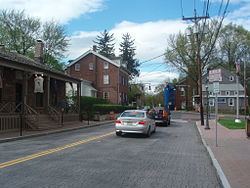County Rockland FIPS code 36-73154 Elevation 14 m Zip code 10983 Area code Area code 845 | State New York Time zone Eastern (EST) (UTC-5) GNIS feature ID 0967057 Area 7.2 km² Population 6,613 (2010) | |
 | ||
The 76 house history tappan new york built 1686
Tappan (pronounced tuh-PAN), Indian word meaning "tuphanne" - translation "cold water", is a hamlet and census-designated place in the town of Orangetown, Rockland County, New York, United States. It is located north of Old Tappan, New Jersey, east of Nauraushaun and Pearl River, south of Blauvelt, and west of Palisades and Sparkill. The population was 6,613 at the 2010 census.
Contents
- The 76 house history tappan new york built 1686
- Map of Tappan NY USA
- Early history
- American Revolution
- Recent history
- Geography
- Demographics
- Historical markers
- Landmarks and places of interest
- In Popular Culture
- References
Map of Tappan, NY, USA
Early history
The Tappan tribe were a Lenape people who inhabited the region radiating from the Hudson Palisades and the New York – New Jersey Highlands at the time of European colonization in the 17th century.
The first Orange County courthouse was built in 1691 in Tappan, though by 1737, sessions alternated between Tappan and Goshen. The first school house in Rockland County was built in 1711 in Tappan. It was used as a school until 1860. There would not be another school in the county until late in the 18th century.
American Revolution
The Orangetown Resolutions were adopted in 1774 at the home of Yoast Mabie. The Dutch colonial house was built by his brother Casparus Mabie in Tappan. When Great Britain imposed duties on the colonies and closed the port of Boston, local inhabitants passed resolutions calling for a boycott of British imports and exports on Monday, July 4, 1774, two years to the day before the Declaration of Independence was proclaimed.
British Major John André, who conspired with Benedict Arnold to allow the takeover of West Point by the British, was captured in 1780 in Tarrytown on his way back to the British lines with the plans of the fort's fortifications. Major André was brought to Tappan, confined at Caspurus Mabie's home, known as "Mabie's Inn," and brought to trial at the Reformed Church of Tappan; he was found guilty of espionage, hanged, and buried nearby.
Agent 355 of the Culper Spy Ring is thought to have played a major role in exposing Arnold and the arrest of Major John André. Strickland, Major André's executioner, who was confined at the camp in Tappan as a dangerous Tory during André's trial, was granted liberty for accepting the duty of hangman and returned to his home in the Ramapo Valley or Smith's Clove. Joshua Hett Smith, accused of conspiring with Major André, was also brought to trial at the Reformed Church of Tappan. The trial lasted four weeks and ended in Smith's acquittal.
General George Washington, who in 1789 became the first president of the United States, used the 1700 DeWint House, Rockland County's oldest existing structure, as his headquarters four times between 1780 and 1783, and dined at Mabie's Inn during the American Revolution. Today the house known as Mabie's Inn is a restaurant operating as The Old 76 House.
Recent history
Geography
Tappan is located at 41°1′33″N 73°57′4″W (41.025897, -73.951180).
According to the United States Census Bureau, the region has a total area of 2.8 square miles (7.3 km2), all land.
Demographics
As of the census of 2000, there were 6,757 people, 2,261 households, and 1,887 families residing in the community. The population density was 2,423.0 per square mile (935.1/km²). There were 2,294 housing units at an average density of 822.6/sq mi (317.5/km²). The racial makeup of the CDP was 82.27% White, 1.27% African American, 0.12% Native American, 13.51% Asian, 0.07% Pacific Islander, 1.48% from other races, and 1.27% from two or more races. Hispanic or Latino of any race were 6.36% of the population.
There were 2,261 households out of which 37.1% had children under the age of 18 living with them, 73.6% were married couples living together, 7.3% had a female householder with no husband present, and 16.5% were non-families. 13.6% of all households were made up of individuals and 7.1% had someone living alone who was 65 years of age or older. The average household size was 2.98 and the average family size was 3.27.
In the region the population was spread out with 24.9% under the age of 18, 6.2% from 18 to 24, 26.0% from 25 to 44, 28.1% from 45 to 64, and 14.8% who were 65 years of age or older. The median age was 41 years. For every 100 females there were 94.7 males. For every 100 females age 18 and over, there were 91.8 males.
The median income for a household in the area was $86,435, and the median income for a family was $91,827. Males had a median income of $57,750 versus $40,707 for females. The per capita income for the CDP was $32,811. About 2.3% of families and 3.3% of the population were below the poverty line, including 2.9% of those under age 18 and 7.4% of those age 65 or over.
